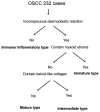Clinicopathological and Prognostic Significance of Stromal Patterns in Oral Squamous Cell Carcinoma
- PMID: 35492308
- PMCID: PMC9051019
- DOI: 10.3389/fmed.2022.859144
Clinicopathological and Prognostic Significance of Stromal Patterns in Oral Squamous Cell Carcinoma
Abstract
Background: Stromal patterns (SP), especially desmoplastic reactions, have recently gained attention as indicators of malignant potential in cancer. In this study, we explored the clinicopathological and prognostic significance of the SP in oral squamous cell carcinoma (OSCC).
Materials and methods: We reviewed 232 cases of surgically resected OSCC that were not treated with neoadjuvant chemoradiotherapy. We categorized the SP of the OSCC into four groups: immune/inflammatory (84 cases), mature (14 cases), intermediate (78 cases), or immature (56 cases).
Results: The SP category was significantly associated with various clinicopathological factors, such as the histological grade, lymphovascular invasion, neural invasion, and a diffuse invasion pattern. For each of the factors, the immune/inflammatory type was associated with favorable categories, while the immature type was associated with unfavorable categories (p ≤ 0.001). The SP category was also shown to be a prognostic predictor: the 5-year relapse-free survival (RFS) rate was 72.0% for the immune/inflammatory type, 66.7% for the intermediate/mature type, and 31.2% for the immature type (p < 0.0001), and the 5-year overall survival (OS) rate was 85.1% for the immune/inflammatory type, 76.4% for the intermediate/mature type, and 50.0% for the immature type (p < 0.0001). In multivariate analyses, the SP category was identified as an independent prognostic factor for RFS and OS.
Conclusion: Our SP categorization method provides valuable prognostic information in OSCC.
Keywords: desmoplastic reaction; epithelial-mesenchymal transition; oral squamous cell carcinoma; prognosis; stromal pattern.
Copyright © 2022 Amano, Kihara, Hasegawa, Miura, Matsubara, Fukushima, Nishino, Mori and Niki.
Conflict of interest statement
The authors declare that the research was conducted in the absence of any commercial or financial relationships that could be construed as a potential conflict of interest.
Figures



Similar articles
-
Correlation of Pattern of Invasion, Stromal Inflammation and Lymphovascular Invasion With Histopathological Grading in Oral Squamous Cell Carcinoma: A Retrospective Study.Cureus. 2024 Jan 13;16(1):e52233. doi: 10.7759/cureus.52233. eCollection 2024 Jan. Cureus. 2024. PMID: 38352087 Free PMC article.
-
Histological categorisation of the desmoplastic reaction is a predictor of patient prognosis in oesophageal squamous cell carcinoma.Histopathology. 2021 Aug;79(2):219-226. doi: 10.1111/his.14357. Epub 2021 May 28. Histopathology. 2021. PMID: 33595141
-
A retrospective investigation of minor risk factors as prognostic predictors and treatment indications in oral squamous cell carcinoma.J Dent Sci. 2021 Jan;16(1):445-452. doi: 10.1016/j.jds.2020.09.012. Epub 2020 Oct 7. J Dent Sci. 2021. PMID: 33384833 Free PMC article.
-
Intraepithelial tumour infiltrating lymphocytes are associated with absence of tumour budding and immature/myxoid desmoplastic reaction, and with better recurrence-free survival in stages I-III colorectal cancer.Histopathology. 2021 Jan;78(2):252-264. doi: 10.1111/his.14211. Epub 2020 Sep 14. Histopathology. 2021. PMID: 32654226 Free PMC article. Review.
-
Prognostic Significance of a Scoring System Combining p16, Smoking, and Drinking Status in a Series of 131 Patients with Oropharyngeal Cancers.Int J Otolaryngol. 2021 Sep 7;2021:8020826. doi: 10.1155/2021/8020826. eCollection 2021. Int J Otolaryngol. 2021. PMID: 34531914 Free PMC article. Review.
Cited by
-
Biomolecular alterations temporally anticipate microarchitectural modifications of collagen in oral tongue squamous cell carcinoma.iScience. 2024 Jun 17;27(7):110303. doi: 10.1016/j.isci.2024.110303. eCollection 2024 Jul 19. iScience. 2024. PMID: 39040062 Free PMC article.
-
Desmoplastic reaction in the microenvironment of head and neck and other solid tumors: the therapeutic barrier.Ther Adv Med Oncol. 2025 Feb 7;17:17588359251317144. doi: 10.1177/17588359251317144. eCollection 2025. Ther Adv Med Oncol. 2025. PMID: 39926258 Free PMC article. Review.
-
Histological pattern of tumor inflammation and stromal density correlate with patient demographics and immuno-oncologic transcriptional profile in oral squamous cell carcinoma.Front Oral Health. 2024 Jun 6;5:1408072. doi: 10.3389/froh.2024.1408072. eCollection 2024. Front Oral Health. 2024. PMID: 38903181 Free PMC article.
-
Pathogenomic fingerprinting to identify associations between tumor morphology and epigenetic states.Eur J Cancer. 2025 May 15;221:115429. doi: 10.1016/j.ejca.2025.115429. Epub 2025 Apr 14. Eur J Cancer. 2025. PMID: 40239399
-
Guanylate binding protein 5 is an immune-related biomarker of oral squamous cell carcinoma: A retrospective prognostic study with bioinformatic analysis.Cancer Med. 2024 Jul;13(13):e7431. doi: 10.1002/cam4.7431. Cancer Med. 2024. PMID: 38978333 Free PMC article.
References
-
- Noguti J, De Moura CF, De Jesus GP, Da Silva VH, Hossaka TA, Oshima CT, et al. . Metastasis from oral cancer: an overview. Cancer Genomics Proteomics. (2012) 9:329–36. - PubMed
-
- Brierley JD. GM and WC UICC TNM Classification of Malignant Tumours. 8th Edn. New York: Wiley Blackwell; (2017).
LinkOut - more resources
Full Text Sources

